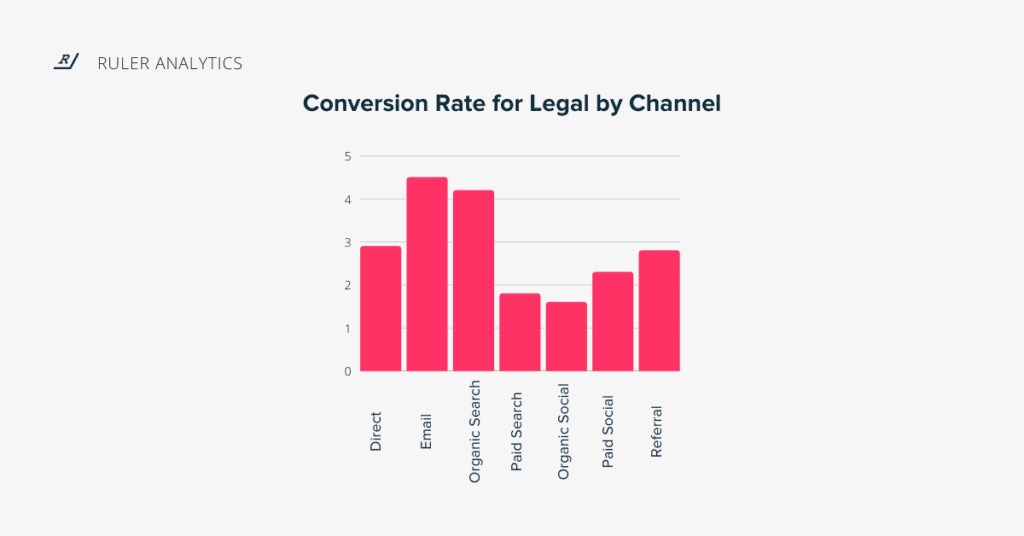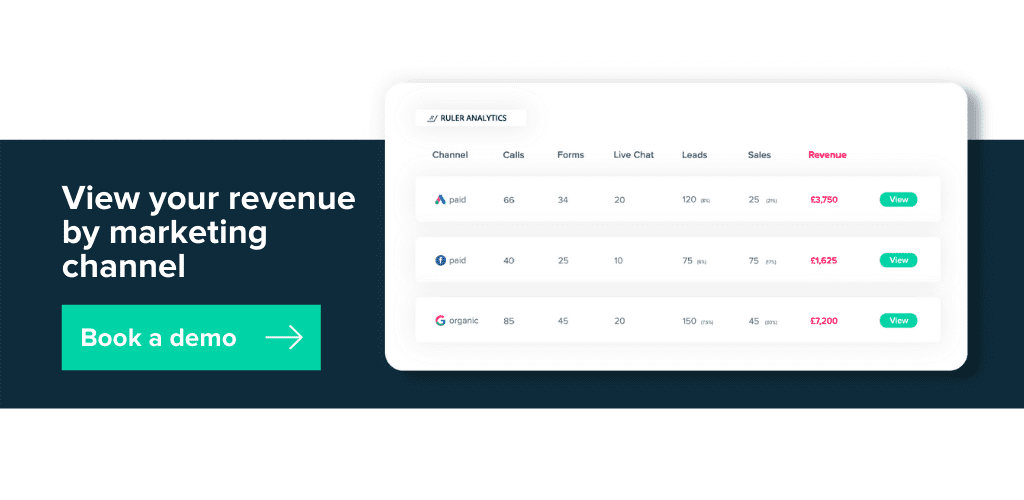Are you a legal marketer looking to drive more revenue through marketing? We go through every tactic you can employ to optimise your marketing and achieve better results.
We work closely with legal marketers. In fact, hundreds of them use our marketing attribution tool each month.
Given we had such a large number of data points when it comes to the legal marketing space, we decided to do some investigation.
We found that on average, the conversion rate in the legal industry across all channels was 2.6%.
But how do you go about improving that conversion rate? Well, for those in the legal space, it’s not easy.
In this blog, we’ll go through:
So let’s get stuck in!
Company to company, legal marketing is going to look very different as it depends on your audience, your services and your strategy.
The aim of legal marketing is to grow business. That might be done by driving more calls or form submissions, or it could be done by organising and attending events.
Firm to firm, there will be an entirely separate strategy and set of goals. But, no matter who you’re targeting or what you’re selling, our legal marketing guide can help you get more from your outputs.
There are always going to be blockers in the way when it comes to making the most of your marketing strategy. Those working in the legal sector will have their own set of challenges.
These usually include:
Back in December 2019, the SRA released new regulations limiting how law firms can advertise themselves to customers. The new regulation prohibits legal firms from making unsolicited approaches to members of the public to advertise legal services unless they’re current or previous clients.
But don’t worry, keep reading for tips on how to grow your brand, and your business, while adhering to this rule.
There are more law firms now than ever before. In fact, in the UK, it’s expected the industry would grow 4.4% in 2021 alone. Meanwhile, existing law firms are diversifying their offering. This means a more and more complicated market to get the competitive edge on.
But, if you understand the true ROI of your channels and campaigns, you can pinpoint exactly what you need to do to drive more towards your bottom line.
Related: How to track marketing ROI
With the growing number of law firms, competition on digital channels has grown too.
In our review of legal marketing data, we found that 58% of all traffic was being generated by paid search. However, paid search actually came out near the bottom when it came to conversion rate, at a 1.8% conversion rate.
The trap with PPC and paid social is that you chase historic results on the same campaign types by adding more budget. Instead, the trick is to understand which campaigns, ads and keywords are driving more sales. But, when you’re relying on offline sales, and operating with long sales cycles, understanding the value of these keywords can be complex.
We’ll show you how to keep improving your return on investment so you’re getting the most out of paid advertising. Learn more about the importance of measuring your return on ad spend with our quick guide.
Long sales cycles in the legal industry make reporting difficult when you’re working with a 90-day cycle on most analytics tools.
Tracking the full customer journey, whether it takes a month, or a year is essential to finding your true ROI.
Hand in hand with long sales cycles are offline conversions. Online searches result in offline conversions, but tracking them and attributing them back to your marketing efforts is complicated.
In fact, we found, for legal, that 61% of inbound enquiries come from a phone call.
Both paid search and organic search tend to see more inbound calls as opposed to form submissions. In fact, for both organic and paid, our data highlighted that calls saw a 2% conversion rate on average while form submissions only saw a 1% conversion rate.
⚡️ Pro Tip
Want more data tidbits like these? Check out our conversion benchmark for legal or read our overview blog on legal marketing statistics.
There are many channels that are perfect for legal marketing professionals to take advantage of. But before we look at what they are, and how they can grow revenue, here are a few things to consider first:
If you’re a marketing professional, you’ll know what a marketing funnel, or buyer’s journey is and that you can’t market without one.
Understanding your users’ touchpoints is vital to deciphering which channels, content and campaigns are working best. Whether they’re driving awareness, supporting your user to consider your product or services, or even making the final decision, it’s vital to understand the role each channel and content piece plays independently and as part of a whole.
That sounds complicated, but we promise it isn’t. With a customer journey map in place, you can start aligning content and channels to set stages of the journey.
🚀 Pro Tip
Not sure where to begin when it comes to customer journey planning? Read our guide to creating your own customer journey map or download our guide to tracking customer touchpoints. It’ll help you to understand how to track how users are currently engaging with you and how to use this insight to improve your outputs.
There’s no point in spending thousands of dollars on paid advertising if the user experience on your site is poor. A strong website is essential to improving your legal marketing efforts. From increasing brand awareness to improving lead quality, a website filled with helpful content and strong calls to action can really help drive your user through the funnel.
And that’s what we want, right?
One integral part of legal marketing is understanding your audience. Particularly for paid advertising, how can you target your ads or content, if you’re not sure who you want to reach?
Sit down with your marketing and sales team to try and draw up one to three client personas. Use demographic data of your current clients to find trends and use these to test future paid advertising campaigns.
Even in your organic marketing, you can use these client personas to understand what questions your users might be asking and create content that helps solve their problems.
Ask yourself:
Understanding the answers to questions like these will help you drill down to a specific target audience that is going to convert.
Developing your brand is important. Increasingly, users are more interested in the people behind an organisation, particularly if that business is selling a service.
According to Sprout Social, 65% of consumers feel more connected to brands that have a robust presence on social. How is this relevant? Well, by creating a strong sense of brand across your digital and offline marketing channels, you can increase your bottom line.
Create a strong brand with a tone of voice guide to allow your team to use relevant language to engage and persuade your audience.
So now you know a bit more of the basics when it comes to legal marketing, you next need to get started building your strategy.
Keep reading for our walkthrough of how to best approach it.
Did you know that 96% of people seeking legal advice use a search engine? Understanding how web users interact with content is essential to prioritising channels in your marketing strategy.
We found some key insights that might be useful for you to consider.
In the legal sector, organic search had a conversion rate of over 4%. That’s significantly higher than the average conversion rate of 2.6% found across all seven channel types analysed.
The best channel in legal marketing as far as conversions are concerned was email marketing which came out at an impressive 4.5% conversion rate. On average, across all channels analysed, the legal sector tends to see a 2.6% conversion rate for inbound calls and form submissions.
Here’s the breakdown channel by channel.

If you build out your strategy based on what works for others, the next step is to test it.
Remember, you should always be reporting on your performance and altering your strategy to ensure you’re making it as optimised as you can.
The best way to do this in the legal sector is with marketing attribution. Ever struggled to connect anonymous website visitors to leads or sales? You’re not alone.
By integrating marketing attribution, you can report on closed revenue as the tool will automatically attribute it to the influencing channels, campaigns and ads.
✏️ Note
Ruler Analytics is a marketing attribution tool that can help you climb over the competition. Check out how Ruler attributes closed revenue back to your marketing.
Often thought of as a purely customer service-based function, live chat is actually a great way to grow your legal leads.
By providing multiple options for your users to contact you, you’re automatically increasing your chances as they can pick their preferred option. Some users are put off by submission forms, while some are put off by phone calls.
And, in this climate where internet users expect immediate responses, live chat is the perfect medium to qualify potential leads and convert them into an opportunity.
It can also be a great way to quickly qualify or remove potential leads.
⚡️Pro Tip
Not sure how you would go about tracking your live chat performance? Download our guide to tracking live chat for the inside scoop.
And it’s not just live chat. By understanding how your ideal client uses the internet, you can better strategise your marketing. Use current clients or benchmark data to test what works and optimise.
There are a whole host of marketing KPIs and metrics you’ll need to consider when looking at your marketing outputs.
From a legal marketing perspective, you need to be concentrating on the following two questions:
Legal marketers mostly concentrate on their lead generation. That’s the count of people who filled in a form, or called your business. But, there are issues with reporting on lead generation only.
The main one is that a lead doesn’t guarantee revenue. What’s your lead quality like? Chances are, you don’t know. If you create a lead as a legal marketer and pass it over to your sales team, you don’t get full visibility of how that lead progresses.
In order to get more efficient data, you need to be tracking your revenue.
Marketing attribution is the missing link. It allows you to see the number of leads compared to the amount of revenue. And you can break that data down by marketing channel, campaign and even keyword. This means you have much more insight into what makes a high-quality lead, meaning you can optimise your marketing to reach a lookalike audience.
🚀 Pro Tip
Want to learn how Ruler attributes revenue to your marketing? Download our guide to closed-loop marketing attribution.
Legal marketers don’t have the ease of driving eCommerce sales on their website, which are easy to track.
Instead, they mostly drive new leads via methods like call, form and live chat.
But the issue with some of these conversion types is that they’re not easy to track.
Phone calls are offline conversions and so very difficult to link to online marketing campaigns. But not impossible.
Related: Complete guide to offline conversion tracking
Legal marketing doesn’t have to be a minefield. When you’re accurately tracking your impact and using that insight to create data-driven decisions you can easily optimise your marketing and scale your business.
The best way to do that is to integrate a marketing attribution tool into your marketing stack.
Besides its ability to capture live chat and form conversions, Ruler can also track phone calls and attribute them to the correct traffic source over multiple sessions, keywords, ads and more.

“Through Ruler’s call tracking we have been able to assign additional value to our campaigns for clients When leads start coming in, you don’t always know who’s coming from where (or which campaign or ads). But with Ruler in place, I can be confident in our monthly marketing meetings by having a clearer picture of what is creating revenue for the company. Ruler has allowed us to find what works and double down on it. ”
Kurt Dunphy, Growth Manager at Rally.
Remember, marketing attribution can be the missing link to drive your business to the next level.
Do you want to find out how Ruler can help you develop your legal marketing? Grow leads, increase traffic but most importantly, increase revenue generation using smart data. Book a demo with our team and start making revenue your most important marketing metric.
